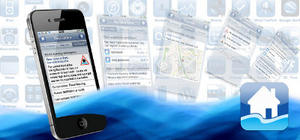DisastersHow smartphones are fighting floods
A new smartphone app is helping the Army Corps of Engineers to strengthen its levees and fight floods in Kansas;filing reports is as simple as using a smartphone to take a picture, adding a note, and uploading the information to a database, which only takes a few seconds; this new system helps reduce the time it takes to gather critical information about levees by as much as thirty-six hours, giving engineers valuable additional time to detect and save a failing levee

From warnings to database building, smartphones fight floods // Source: halcrow.com
A new smartphone app is helping the Army Corps of Engineers to strengthen its levees and fight floods in Kansas.
In the past when civil engineers identified weak spots in levees, they had to take a picture with a digital camera, note the location, drive back to their desks, download the photo, and file a written report. Now filing reports is as simple as using a smartphone to take a picture, adding a note, and uploading the information to a database, which only takes a few seconds.
This new system helps reduce the time it takes to gather critical information about levees by as much as thirty-six hours, giving engineers valuable additional time to detect and save a failing levee.
“The ability to get somewhere fast and take a picture and send it back is far superior to having someone get in the car and drive,” said Jud Kneuvean, director of emergency management for the Corps of Engineers’ Kansas City district.“ This allows us to do real-time analysis of conditions on the ground.”
Under the new system, when engineers take a photo of a trouble spot it is automatically “geotagged,” so the exact location, time, and date, of the photo are recorded. In addition, Corps engineers can attach videos, voice recordings, and text notes to their reports. In particular, the system is used to find and record sand boils, breaches, seepage, overtoppings and other problems along a levee system.
According to Corps officials, the smartphone app helps increase efficiency, speed, and accuracy.
Michael Dulin, who flies aerial reconnaissance missions for the corps, said that the app helps to focus resources.
“Being able to know exactly where you are at, see what is going on and relay that to field teams keeps them from having to wander around,” Dulin said.
Patrick Line, a geographer with the Corps, added, “If there are hot spots that may require further assistance or support, we can act much quicker.”
In addition, the smartphone’s automatic geotagging feature essentially eliminates human error where an engineer at times can mislabel or misreport problems at levees.
“There are so many people looking at levees now and paying attention that it’s more important than ever to filter through reports and make sure they are true,” Kneuvean said.
Kneuvean did say that the new system can at times overwhelm the corps with a deluge of information. On a single day, the corps receives as many as 500 photos, but Kneuvean said that these photos can then be stored and analyzed to help determine problematic areas in the future.
